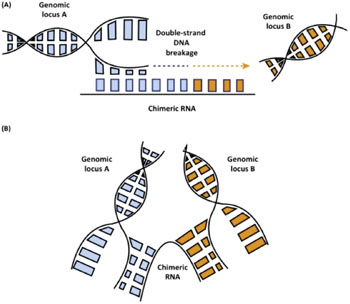Strange Chimeras Defy Scientific Understanding of Human Genetics
By LabMedica International staff writers
Posted on 18 Oct 2016
The human genome is far more complex than thought, with genes functioning in an unexpected fashion that scientists have wrongly assumed must indicate cancer as gene fusions and their encoded products fusion ribonucleic acids (RNAs) and proteins are viewed as one of the hallmarks of cancer.Posted on 18 Oct 2016
Traditionally, gene fusions were thought to be generated solely by chromosomal rearrangements. However, recent discoveries of trans-splicing and cis-splicing events between neighboring genes suggest that there are other mechanisms to generate chimeric fusion RNAs without corresponding changes in DNA.

Image: A diagram of mechanisms of RNA-Mediated DNA Rearrangement. (A) Chimeric RNAs act as repair templates for double-strand DNA breakage. (B) Chimeric RNAs act as scaffolds to bring two genomic loci into proximity, which might promote breakage and fusion between the two gene loci (Photo courtesy of the University of Virginia).
Scientists at the University of Virginia (Charlottesville, VA, USA) have reviewed the emerging field that is challenging fundamental assumptions about human genetics. They seek to understand what is called chimeric RNA, genetic material that results when genes on two different chromosomes produce "fusion" RNA in a way scientists say should not happen. Scientists have traditionally assumed these chimeric RNA are signs of cancer, of something gone wrong in the genetic transcription process, but the investigators work shows that's not always the case. Instead, these strange fusions can also be a normal, functional part of our genetic programming.
In addition, chimeric RNAs have been detected in normal physiology, complicating the use of fusions in cancer detection and therapy. By contrast, ‘intergenically spliced’ fusion RNAs represents a new repertoire of biomarkers and therapeutic targets. The team reviewed the current knowledge on chimeric RNAs and implications for cancer detection and treatment, and discusses outstanding questions for the advancement of the field.
Hui Li, PhD, an associate professor of Pathology and senior author of the study, said, “This is the main concept we want to let the field of cancer biology know: this kind of thing exists in normal physiology. It's not cancer specific. There's a danger to assuming everything is cancer. That's actually dangerous. Don't rush to judgment about all of these chimeras you find in cancer cells, because they could occur in normal cells.”
Because these natural chimeras were discovered so recently, relatively little is known about them. Professor Li and his fellow scientists have shown that they occur when the instructions in our DNA are being carried out by RNA inside our cells. But the scientists can't say how the fusions occur or why they occur or exactly how frequently they occur. And that speaks to how much there is to learn. To build a foundation for discovery, Professor Li is creating a database of naturally occurring fusions, to help sort normal chimeras from ones that might be signs of cancer The study was published in the September 2016 issue of the journal Trends in Cancer.
Related Links:
University of Virginia




 assay.jpg)









